Without the philanthropist Roland Philipson, who died on the 19th September 1906, the Stannington Sanatorium and Farm Colony would have been drastically different, or may never have existed at all. Descended from Philip de Thirlwall of Thirlwall castle, the Philipson family were famous for coach and train carriage building, and as solicitors and Aldermen of Newcastle. However they were also famous for their philanthropy, establishing many institutions and hospitals, for which Men of Mark Twixt Tyne and Tweed by Richard Welford is recommended reading. Roland’s grandfather, Ralph Park Philipson, was Town Clerk, Alderman, and solicitor to the North-Eastern Railway Company. It was after Ralph’s wife the ‘Philipson Memorial Orphan Asylum’ on Newcastle Town Moor was dedicated, a cause supported by the family for many generations. Roland’s father Hilton was a Justice of the Peace in Newcastle, and he and his wife Jane had five children. Born in Tynemouth in 1863, Roland was raised with his brothers Ralph and Hylton, and sisters Annie and Mary Seely Philipson, later Woosnam. He and his brothers attended Eton, where they can be found on the 1881 census.
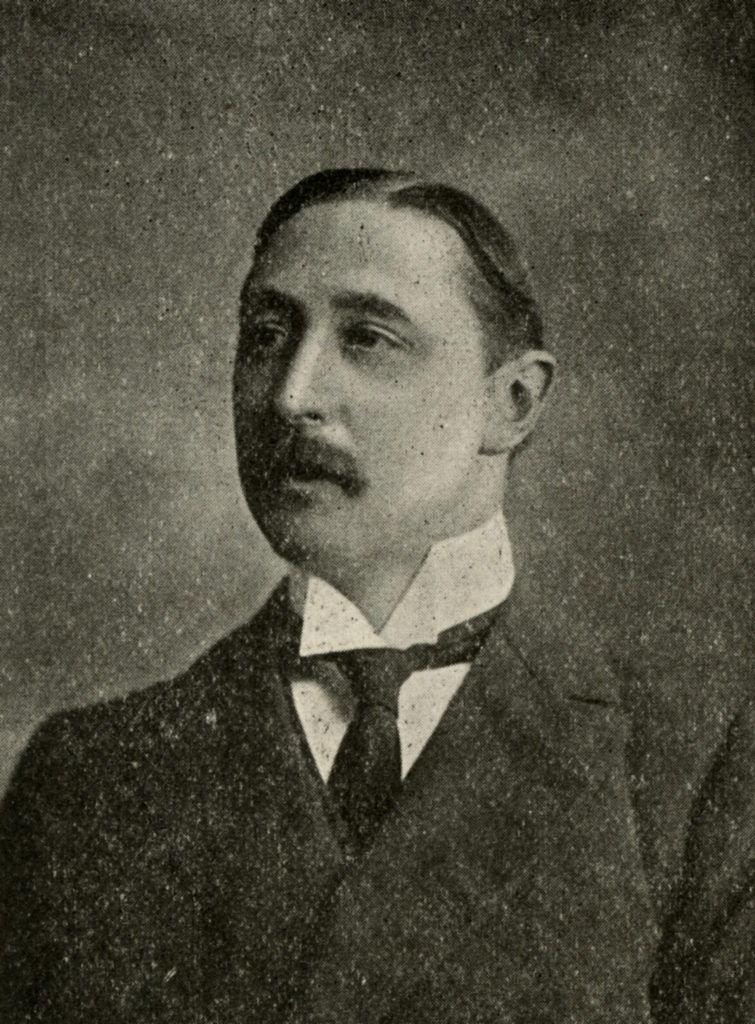
He is described in later census as a mechanical engineer, and on the 2nd June 1905 became a director of the North-Eastern Railway Company. He was also involved in several coal companies, and was a director for the Wallsend Slipway Company, the Consett Iron Company, and North-Eastern Marine Engineering Company. As a Justice of the Peace he acted as chairman for the Wallsend Petty Sessions, and was a Juror at the Northumberland Assizes. The census and Kelly’s directories show he lived at 6 Prior’s Terrace, Tynemouth, but likely had other residences, possibly including one at Howick. He married Louisa Warden Parr in 1888 in Chorlton, Lancashire. She was born in North Shields. They had sons Hilton, Roland Thirlwall and Thirlwall, and a daughter, Vera. Roland was a philanthropist like the rest of his family, and gave the Tynemouth Volunteer Life Brigade £2000 for a searchlight to help rescuers.
Mr John H. Watson, a founder and later Secretary of the PCHA, established the Newcastle Poor Children’s Holiday Association and Rescue Agency in 1888, to tackle the impact of poverty on children and bring homeless children off the streets (EP 10/75). When on holiday he came up with the idea of taking children from the slum areas of Newcastle to the country or the seaside, the Victorian ideals of a healthy environment. It began as a trip for 100 children for an afternoon to the seaside. By 1908 there had been 125,000 children go on holidays and outings with the association, and it owned training, convalescent, and other homes.
It was realised many of the children attending had Tuberculosis. They were unable to go with the group for fear of spreading the disease, despite perhaps being the most in need of a holiday. In 1894 the agency sent ‘delicate and ailing’ children on a three week holiday, and, on finding it helped their condition, established a convalescent home at Shotley Bridge for 60 children. In 1904 it was decided to establish a similar one at Stannington, with a Children’s Consumptive Sanatorium, and that along with £500 given by Robert Scott a further £5000 would be necessary for the work. They also decided to tackle the problem of a lack of training for the boys in their care by creating a Farm Colony to provide training for boys from the city.
An article in the Stannington Parish News in 1971 describes the story of how Roland and his wife came to hear about the plan (EP 10/75). The circulars about the appeal sent out by the agency went to numerous houses, including the Philipsons’ in Tynemouth. They were at the time on Holiday in Naples, and the household sent it on to them. The article describes Roland turning to his wife upon reading it, and asking her what they should do for the appeal:
“Mrs Philipson said that she thought they should do something worthy of the cause and the occasion. At this Mr Philipson left the room and sent a wire to the agency stating that he would donate the required £5000!”
A newspaper article in the Yorkshire Post on Thursday 14th September 1905 described the new venture in great detail, and that Mr and Mrs Philipson would be there to lay the foundation stone that Saturday.
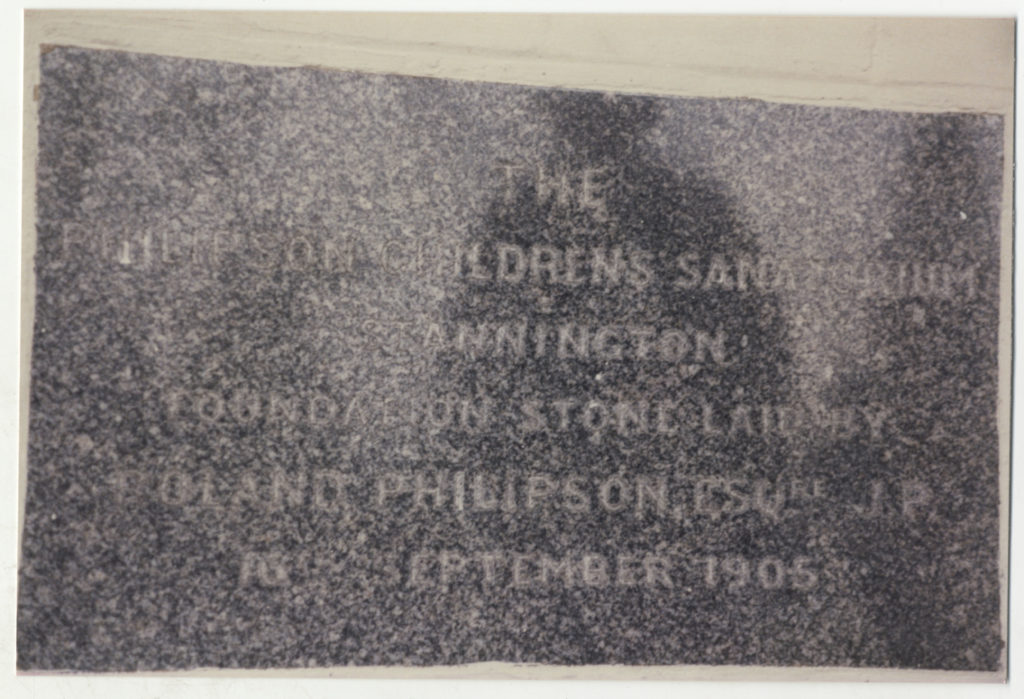
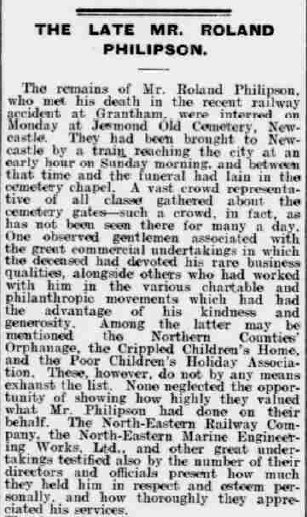
However Roland never saw the building work finished, as on the 19th September 1906 he was on a train heading through Grantham which derailed, killing him and thirteen other passengers, and injuring several others. The inquiry into the accident was unable to ascertain why it happened, but reported that the train, an overnight mail and passenger train travelling from Kings Cross to Edinburgh, had failed to stop at Grantham, ignoring the signals. It derailed a few hundred yards from the station, where the train fell down an embankment, the engine turning over completely. The wooden carriages broke in pieces in the fall, and caught fire as they were lit by gas lamps.
A letter from his grandson Major Anthony T. Philipson of the Scots Guards to the Reverend B. G. Sullivan, Vicar of Stannington, states Roland had just taken his son, Anthony’s father, back to Eton (EP 10/102). It is possible his return back up to Newcastle was timed to see the launch of the Cunard ocean liner the RMS Mauretania due to launch the next day, 20th September. His funeral took place at Jesmond Cemetery and was conducted by Dr Lloyd, Bishop of Newcastle, Canon Gough, vicar of Newcastle, and Canon Hicks, vicar of Tynemouth. His brother-in-law Canon Charles Maxwell Woosnam of Brighton also helped to officiate.
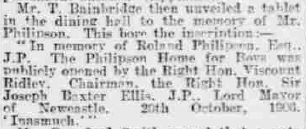
After his death Louisa moved between Tynemouth and a house in Park Lane, London, and it was there that Vera was married in 1927 to Eustace F. Moyes, a Flight Commander with the Royal Naval Air Service in WWI. Hylton became a Captain in the Scots Guards and stood as a candidate for Conservative MP several times. His wife, comic actress Mabel Russell, achieved a political career as Unionist MP for Berwick from 1924-1929, and was one of the first female MPs in the House of Commons (see the Berwickshire News and General Advertiser for Tuesday 21 October 1924). Roland Thirlwall became a Captain in Coldstream Guards during the First World War. Thirlwall became a Major in the Life Guards, and, like many other members of the family, was president of the Northern Counties Orphanage. He married and divorced actress Nellie Briercliffe, and later married Daphne Gladstone.
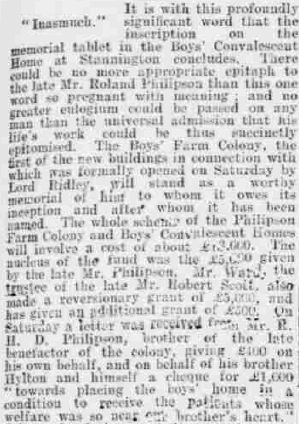
The Philipson Farm Colony continued to be remembered by the family in later bequests, visits and wills. In his letter (EP 10/102, dated 22 Dec 1971) Major Philipson thanked Reverend Sullivan for a copy of the December Stannington parish magazine he had received, and said he had greatly enjoyed an article on Roland Philipson it contained. He had visited the Farm Colony in 1947, ‘but gathered it had finished some time before the 1939-45 war. Any survivors would be in Australia or New Zealand.’ He clearly enjoyed the remembrance of his Grandfather’s part in the creation of the sanatorium and the farm Colony, and said his aunt, as Roland’s only surviving child, would as well. He added ‘Thank you for drawing a hand across the strings of memory’ (EP 10/102).
For more on the story have a look at our previous blog post and exhibition.

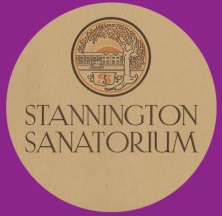
You should ask children like myself who were at stannington in the early sixties for asthma and other ailments. We were I’ll treated in a way that if it happened today there would be prosecutions I am sure of that.l was in there for 9 months and it was horrific at times.
Enjoyed the read “inasmuch” as you so rightly said Roland Philipson led the way to thousands of children being treated and cured from TB and other respiratory ailments, a man of vision. Iv’e read that he was laid to rest at Jesmond Old Cemetery. Oh and by the way my time at Stannington in the early sixties could not be more different than that of Bill Straker.
Our apologies Ian, we have corrected the mistake!
Many thanks, The Stannington Sanatorium Project Team.